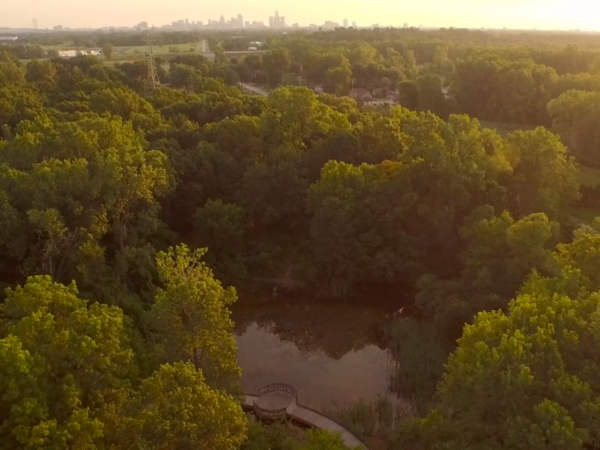
By Zahra Ahmad, Bridge Michigan
The Great Lakes News Collaborative includes Bridge Michigan; Circle of Blue; Great Lakes Now at Detroit Public Television; and Michigan Radio, Michigan’s NPR News Leader; who work together to bring audiences news and information about the impact of climate change, pollution, and aging infrastructure on the Great Lakes and drinking water. This independent journalism is supported by the Charles Stewart Mott Foundation. Find all the work HERE.
Among the arguments used by Canadian energy giant Enbridge in support of its Line 5 pipeline that runs through Michigan is that, if it’s closed, there will be a significant impact on energy prices for consumers.
But a new report, released Wednesday, takes issue with that assessment, concluding that any energy increases will be modest if the shutdown is coordinated properly.
Environmental Defence Canada, an environmental group, commissioned the report from experts in the gas and oil sector. It suggests that shutting down Line 5 is manageable and that there are other options to meet Canada’s demand for oil and gas.
The report, written by Martin Meyers of Meyers Energy Consulting, LLC, found there are viable alternatives to Line 5, which runs from Wisconsin down through the environmentally sensitive Straits of Mackinac through Michigan to Sarnia, Ontario.
Enbridge Line 78, for instance, flows from Illinois through Indiana to Sarnia, the report notes, and can be run at greater capacity to help recoup oil lost from Line 5. In addition, adding rail and truck capacity, as well as one more marine tanker, can make up the remaining shortfall.
“The impact of these changes on consumer prices for refined petroleum products such as gasoline and diesel fuel in Ontario and Quebec would likely be very modest, to the point that such changes would likely go unnoticed,” the report concludes. [Disclosure: Research for the report was supported by the Charles Stewart Mott Foundation, which is a funder of The Center for Michigan, which includes Bridge Michigan. Mott had no role in the reporting or writing of this article.]
Line 5 is part of Enbridge’s oil and gas pipeline system in western Canada. It carries oil from Superior, Wisconsin through the Straits of Mackinac into Michigan, reaching refineries in Sarnia, Ontario.
Opponents of Line 5 and Indigenous tribes want the oil pipeline shut down, saying the aging pipes pose a risk of polluting the Great Lakes, the world’s largest accessible body of freshwater.
Proponents argue the pipeline is safe and well monitored and must remain open to keep trade, jobs and the economy going. They also claim that, without Line 5, Canada and rural northern Michigan will face an energy crisis because there isn’t an alternative to it.
Whitney Gravelle, attorney for and chairperson of the Bay Mills Indian Community, opposes Line 5 and believes the new report supports Tribal Nations’ appeals to shut down the pipeline and any additions to it.
“It only reaffirms essentially what we’ve been saying all along here in the state of Michigan and from our respective tribal nations that Line 5 can be decommissioned and shut down with minimal impacts,” Gravelle said.
Michigan Gov. Gretchen Whitmer announced the state would shut down Line 5 in 2021 but that effort is currently tied up in federal litigation with Enbridge. Canada is backing the Canadian energy company and contends that any efforts by Michigan to shut down the pipeline would breach an international treaty between the two countries.
Robert Leddy, a spokesperson for Whitmer, said Tuesday the governor intends on following through with closing Line 5, but he did not specifically comment on the report’s findings.
“Governor Whitmer has put in place a plan to protect jobs, diversify and expand our renewable energy resources, and ensure Michigan’s energy needs are met, while also taking action to get the oil out of the water as soon as possible,” Leddy said.
Line 5 can transport 570,000 barrels of oil a day to Sarnia. According to the report, increasing Line 78 capacity would recoup 119,000 barrels daily.
Line 78 was built between 2011 and 2015 to replace another Enbridge pipeline that spilled more than 3 million liters of oil into Michigan’s Kalamazoo River in 2010. According to Meyers, putting Line 78 at peak capacity would not require any work on the pipeline itself if Enbridge upgrades and adds more pumping stations.
But Enbridge spokesperson Ryan Duffy disputed that notion Tuesday, saying Line 78 is not able to transport natural gas liquids and is already “substantially full.” Duffy said the company is not exploring any alternatives to closing Line 5.
Michelle Woodhouse, Environmental Defence Canada’s water program manager, said there is always an added risk of an oil leak if Line 78 is operated at full capacity, but she said it’s riskier to keep Line 5 open because of its age and deterioration.
Line 5 is 69 years old, which makes it 19 years past its designated lifespan of 50 years. According to the report, since Line 5 opened in 1953, it has leaked oil into the Great Lakes 29 times, a total of 4.5 million liters of oil.
“There is always a risk with running oil pipelines,” Woodhouse said. “But Line 78 is a new pipeline. It’s not running through the heart of the Great Lakes or suffering from a state of disrepair.”
Aside from increasing pipeline capacity, Woodhouse said there are other options for energy transport if Line 5 is closed.
One option is trains. Right now, about 110,000 barrels are delivered to Sarnia daily by railroad. The report argues that adding more trains and increasing railroad capacity would not be hard.
But according to Duffy, developing new rails would take years to permit and build. He also noted that more trains and trucks mean more tailpipe emissions.
“To replace the energy being delivered by Line 5 with other methods, such as tanker trucks or rail cars is not in the best interest of the environment or the safety of the public,” Duffy said in a statement. “Based on the energy needs of Michigan, other Great Lakes states, and Canada’s two largest provinces, it makes little sense to shut Line 5 down.”
Line 5 is one of two Enbridge pipelines capable of carrying natural gas, according to Duffy. It carries 80,000 barrels per day, some of which is used to heat homes in the Upper Peninsula.
If Line 5 is shut down, natural gas providers will have to source energy from nearby regions.
Whitmer’s plan to address the natural gas shortfall calls for millions of dollars of investment in rail infrastructure and storage to help wean propane suppliers off the pipeline, plus other programs to reduce propane demand, help low-income customers pay their propane bills, and increase the state’s ability to monitor propane supplies.
Woodhouse said the energy market is flexible and natural gas providers will find alternative sources when it is necessary.
“Whether natural gas liquid comes from Canada or another region, the fact is the product can still make it to market,” Woodhouse said.
Catch more news on Great Lakes Now:
Enbridge returns to court for Line 5 permit
Ignore the buzz, here’s why Enbridge Line 5 won’t likely close anytime soon
Featured image: This July 19, 2002, file photo, shows the Mackinac Bridge that spans the Straits of Mackinac from Mackinaw City, Mich. Michigan Gov. Gretchen Whitmer, ordered Canadian energy company Enbridge last fall to shut down its Line 5 — a key piece of a crude delivery network from Alberta’s oil fields to refineries in the U.S. Midwest and eastern Canada. A section roughly 4 miles (6.4 kilometers) long crosses the bottom of Michigan’s Straits of Mackinac, which connects Lake Michigan and Lake Huron. (AP Photo/Carlos Osorio, File)




